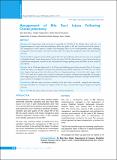Please use this identifier to cite or link to this item:
https://hdl.handle.net/20.500.14356/1264Full metadata record
| DC Field | Value | Language |
|---|---|---|
| dc.contributor.author | Malla, Bala Ram | - |
| dc.contributor.author | Rajbhandari, Nripesh | - |
| dc.contributor.author | Karmacharya, Robin Man | - |
| dc.date.accessioned | 2023-05-04T06:32:52Z | - |
| dc.date.available | 2023-05-04T06:32:52Z | - |
| dc.date.issued | 2020 | - |
| dc.identifier.citation | MallaB. R., RajbhandariN., & KarmacharyaR. M. (2020). Management of Bile Duct Injury Following Cholecystectomy. Journal of Nepal Health Research Council, 18(2), 214-218. https://doi.org/10.33314/jnhrc.v18i2.1579 | en_US |
| dc.identifier.issn | Print ISSN: 1727-5482; Online ISSN: 1999-6217 | - |
| dc.identifier.uri | http://103.69.126.140:8080/handle/20.500.14356/1264 | - |
| dc.description | Original Article | en_US |
| dc.description.abstract | Abstract Background: Laparoscopic cholecystectomy is responsible for 80-85% of the bileduct injury, and twice as frequentcompared to open cholecystectomy.Injury affects the quality of life and overall survival of the patient. The management of these injuries is complex and challenging. There are few locally published reports regarding management of bile duct injury. The objective of this study is to evaluate the management of bile duct injury and its outcome Methods: This retrospective study includes patients bile duct injury following cholecystectomy who were managed at Dhulikhel Hospital, Nepal, during January 2014 to December 2016. The clinical features, type of injuries(Strasberg classification) management, outcome (as per McDonald and colleague grading system) and follow up were analyzed descriptively. Results: Out of 35 bile duct injuries,only 3 (8.57%)occurred following open cholecystectomy. Three (8.7%) cases of bile duct injury were diagnosed intraoperatively and had primary biliary anastomosis over T-tube. Five (14.28%) were diagnosed postoperatively and underwent Roux-en-y hepatojejunostomy 6 weeks after index surgery. And, 27(77.14%) with type A injuries were treated by endoscopic retrograde cholangio-pancreatography and stenting. After surgical repair, 1 (2.85%) had transient biliary leak. One patient had grade B outcome. During 18 months follow up, no stricture or cholangitis were observed. Conclusions: Bile duct injury with intact continuity of the duct can be successfully managed with endoscopic stenting of the biliary tree. Intraoperative diagnosis of bile duct injury and immediate surgical management has good outcome. Keywords: Bile duct injury; cholecystectomy; repair; strasberg classification | en_US |
| dc.language.iso | en | en_US |
| dc.publisher | Nepal Health Research Council | en_US |
| dc.relation.ispartofseries | Apr-June, 2020;1579 | - |
| dc.subject | Bile duct injury | en_US |
| dc.subject | cholecystectomy | en_US |
| dc.subject | repair | en_US |
| dc.subject | strasberg classification | en_US |
| dc.title | Management of Bile Duct Injury Following Cholecystectomy | en_US |
| dc.type | Journal Article | en_US |
| local.journal.category | Original Article | - |
| Appears in Collections: | Vol. 18 No. 2 Issue 47 Apr-Jun 2020 | |
Files in This Item:
| File | Description | Size | Format | |
|---|---|---|---|---|
| 1579-Manuscript-17518-1-10-20200911.pdf | Fulltext Download | 219.08 kB | Adobe PDF |  View/Open |
Items in DSpace are protected by copyright, with all rights reserved, unless otherwise indicated.
